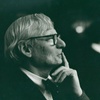Disclaimer
This entry contains information known to us from a variety of sources but may not include all the information currently available. Please be in touch if you notice any inadvertent mistakes in our presentation or have additional knowledge or sources to share. Thank you.
Archive
Louis I. Kahn: National Assembly at Dhaka, Bangladesh
At first glance, the Jatiyo Sangsad Bhaban (National Parliament House) of Bangladesh looks like something out of high fantasy or even science fiction. A monolithic, almost sculptural, concrete building, perforated by huge geometric windows, rises from an artificial lake in the heart of Dhaka like a mythical fortress or a monument left behind by aliens. Designed by American Jewish architect Louis I. Kahn and completed in 1982, the building and surrounding area comprise one of the largest legislative complexes in the world. Kahn’s biographer described the building as “one of the twentieth century’s greatest monuments, and…without question Kahn’s magnum opus”.1
Description
Louis I. Kahn Louis Kahn was born Itze-Leib Schmuilowsky in Estonia in 1901. His family emigrated to America in 1905, and when they became naturalized citizens ten years later, his parents took the surname Kahn and “Americanized” the family’s names.2 After studying at the University of Pennsylvania, Kahn established his own architectural office at the age of 36. His early projects focused on low-cost public housing; although he was concerned with urban issues, they were also the only projects available to an unknown architect.3 His first major commission came in 1951, when he designed an extension to the Yale Art Gallery. The building attracted national recognition, and is said to have revolutionized American museum architecture.4 In the 1950s and 60s he designed scientific facilities at the University of Pennsylvania and the Salk Institute in California, as well as the buildings for the Indian Institute of Management in Ahmedabad. Most of his work was in the International and Modernist styles, and he was fascinated by the interplay of space and light.5 Kahn did not live to see the completion of his two greatest projects, the Yale Center for British Art and the National Assembly building in Bangladesh; he died of a heart attack in Penn Station in 1974.
History In 1962, the government of Pakistan commissioned Louis Kahn to design a building that they intended to be an extension of their parliamentary headquarters.6 Construction halted in March 1971 when Bangladesh declared independence from Pakistan; after the two countries officially separated that December, the project became a symbol of pride and democracy for the Bengali people. Kahn designed the entire legislative complex, including the lawns, the artificial lake, and residences for the members of parliament. The building was completed in 1982—six years after Kahn’s death—at a cost more than double the original estimate. On February 15, 1982, the building opened for the eighth session of Bangladesh’s second parliament.
Design Ayub Khan, who commissioned Louis Kahn to design the building, gave the architect almost unlimited funding and expressed little interest in the design or character of the building. With such creative and economic freedom, Kahn strove to represent Bangladeshi culture and heritage while optimizing the space and creating a truly impressive “citadel of assembly”.7 He was inspired by the transformative effects of democracy: “I fell out of bed with the idea which is still the prevailing idea of the plan [of the National Assembly building]. This came simply from the realization that assembly is of a transcendent nature. Men came to assemble not for personal gain, but to touch the spirit of commonness”.8 He designed eight halls around the central parliamentary chamber, symbolically placing the government at the heart of the building. The huge geometric windows were a key part of the building, allowing Kahn to play with the idea of light not just as illumination but also as a creator of space.9 The material homogeneity gave the building a monolithic, sculptural look, as though it had been cast in one piece.10
Sources
[1] Thuroczy, Maria. “National Assembly Building of Bangladesh.” Architectuul. June 10, 2014. Accessed July 15, 2014. http://architectuul.com/architecture/national-assembly-building-of-bangladesh
[2] Kimbell Art Museum. “Louis Kahn.” Accessed July 15, 2014. https://www.kimbellart.org/architecture/kahn-building/louis-kahn
[3] Ibid.
[4] Ibid.
[5] Ibid.
[6] Kroll, Andrew. “AD Classics: National Assembly Building of Bangladesh/Louis Kahn.” ArchDaily. October 20, 2012. Accessed July 15, 2014. http://www.archdaily.com/83071/ad-classics-national-assembly-building-of-bangladesh-louis-kahn/
[7] Goldhagen, Sarah Williams. Louis Kahn’s Situated Modernism. New Haven: Yale University Press, 2001. 173. Accessed July 15, 2014. http://books.google.com/books?id=t6ztYionekIC
[8] Ibid, 168.
[9] Kroll. “AD Classics: National Assembly Building of Bangladesh/Louis Kahn.”
[10] Gast, Klaus-Peter. Louis I. Kahn, trans. Susanne Schindler. Basel: Birkhauser, 1999. Accessed July 15, 2014. http://books.google.com/books?id=I4O-EFINQNYC









![Bangladesh National Assembly, Exterior and Lake [3] (Dhaka, Bangladesh, n.d.)](https://cdn.filestackcontent.com/je3P6jAOTLCQP7UNin9O/convert?w=100&h=100&fit=crop)


![Bangladesh National Assembly, Exterior and Lake [2] (Dhaka, Bangladesh, n.d.)](https://cdn.filestackcontent.com/CnqeZYfXSwaPSpPgrTtB/convert?w=100&h=100&fit=crop)

![Bangladesh National Assembly, Exterior and Lake [1] (Dhaka, Bangladesh, n.d.)](https://cdn.filestackcontent.com/N8Cm6MLShCBwZLwBUR7Q/convert?w=100&h=100&fit=crop)